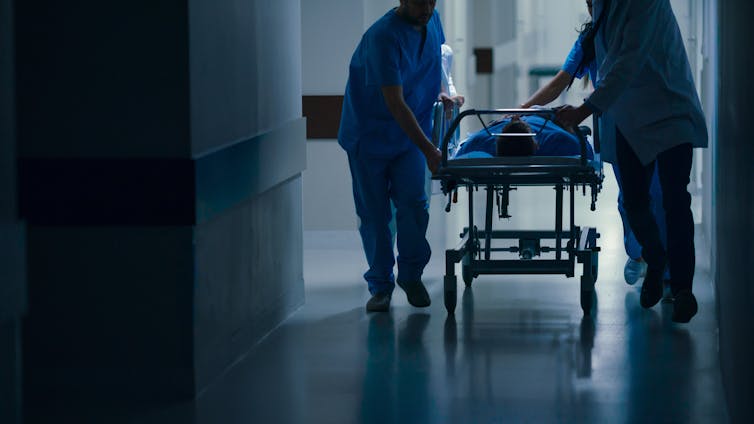There's a mental health emergency happening in South Australia. We need a radical overhaul
- Written by Michael Musker, Senior Research Fellow, South Australian Health & Medical Research Institute
While all eyes are on Australia’s severely faltering vaccine rollout, in South Australia the public health system is in a state of turmoil.
Former Central Adelaide Local Health Network mental health director John Mendoza — effectively the state’s mental health boss until he resigned last week — has blasted the South Australian government, alleging a series of failures, budget cuts, and lack of commitment to reforming the state’s mental health system.
So what’s the problem, and how can it be fixed?
Over capacity
Demand for mental health services has increased over the past year because of the COVID pandemic.
While this is true across Australia, the demand for mental health support is now overwhelming South Australian emergency departments. Mendoza noted close to a 40% increase in mental health presentations to the Royal Adelaide Hospital between February 2019 and February 2021.
According to Australian Institute of Health and Welfare data, South Australia falls below the national average when it comes to treating patients who present to emergency departments in a timely manner.
Through no fault of their own, people in mental health crisis are creating a backlog in emergency departments, contributing to overcrowding, long wait times for admission, and therefore ramping — where patients are left waiting in ambulances at the hospital entrance.
Ambulance services in South Australia are reportedly at breaking point.
Read more: Waiting for better care: why Australia’s hospitals and health care are failing
Ramping
The issue of ramping is emblematic of the crisis in emergency department access.
An investigation into ramping at South Australian hospitals conducted before the pandemic found more than 34% of mental health patients brought by ambulance to South Australian emergency departments experienced ramping.
These delays in receiving care, sometimes lasting several hours, can exacerbate psychological trauma and even cause harm for patients.
The problem of ramping affects patients with physical illnesses too. And because paramedics need to stay with patients for longer, ramping also diverts paramedics from other jobs.
 When emergency departments struggle to keep up, it can lead to ramping.
Shutterstock
When emergency departments struggle to keep up, it can lead to ramping.
Shutterstock
While John Mendoza’s controversial exit has lifted the lid on the crisis in South Australia’s public health system, other states and territories face similar problems in emergency mental health care. And for other jurisdictions, too, the pandemic might exacerbate these challenges.
The ED should be a last resort
In a responsive, modern mental health-care system, the emergency department should be the last resort for access to care.
The Grattan Institute has suggested there’s a “a yawning gap for people who need intensive community support but not inpatient care”. In a report published in 2020, it said federal and state governments need to work more closely to provide appropriate resources for mental health care.
The focus should be on health promotion and prevention through mental health programs and services in the community rather than waiting for a crisis to occur. We need accurate surveillance of demand for mental health care, and services must be well-resourced to prevent the system becoming overwhelmed.
Upon his resignation, Mendoza sounded alarm bells that this was not happening. He warned that South Australia’s mental health system is approaching crisis unless the government allocates additional resources urgently.
Mendoza has been supported by senior mental health staff and the Royal Australian and New Zealand College of Psychiatrists, who argued South Australians deserve better.
Read more: We can't ignore mental illness prevention in a COVID-19 world
A radical overhaul
Mendoza outlined a ten-point plan to radically overhaul South Australia’s mental health system.
Among the recommendations is recruiting more mental health staff. Chronic under-resourcing in community teams at present means the remaining staff are overworked and stressed attempting to fill the gaps. This inevitably leads to consumer needs not being met, resulting in increased emergency department presentations.
Meanwhile, he’s called for upskilling of first responders. This involves providing specialised training for emergency personnel, such as police and ambulance staff, around supporting people in a mental health crisis.
Mendoza also flagged the importance of non-ambulance transfers for mental health patients — so having dedicated vehicles to transport mental health patients. South Australia is the only jurisdiction still exclusively using stretcher-based transport for all mental health patients, meaning they’re strapped in inside the ambulance. This restrictive practice is unnecessary, traumatising, and contributes to ramping.
Further, Mendoza recommended upscaling current prevention programs. These include programs providing mental health expertise to support local general practitioners, and increasing support in people’s homes.
He also suggested providing emergency accommodation for people experiencing homelessness with mental health issues, recognising homelessness is a key cause of social stress.
Importantly, Mendoza strongly advocated that forensic patients (people with a mental disorder who have committed a crime) shouldn’t be housed in general hospitals while waiting for a mental health bed. This means providing an adequate number of beds for forensic mental health admissions (the target is 80, up from the 60 we have now).
Currently, patients unable to access care in a specialist forensic psychiatric facility are reportedly restrained with handcuffs and surrounded by security guards in the emergency department.
Read more: From asylums to GP clinics: the missing middle in mental health care
The ten-point plan offers insightful recommendations from someone who has a deep understanding and experience of the inner workings of the current mental health system, available resources, and areas of weakness. And while it’s designed to fix South Australia’s crisis, there are some recommendations other states would do well to consider.
For South Australia moving forward, the most critical aspect will be easing the pressure on emergency departments by providing targeted staffing resources within community care networks. The second is changing the way mental health patients are transported to hospital.
Authors: Michael Musker, Senior Research Fellow, South Australian Health & Medical Research Institute





